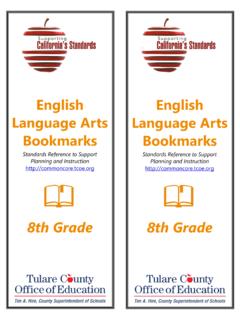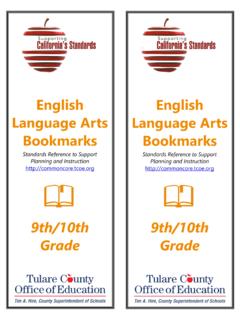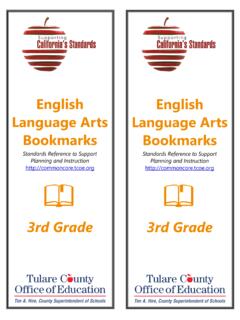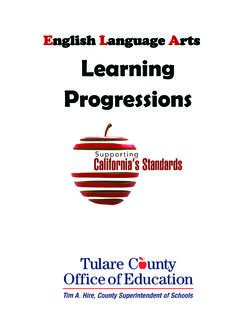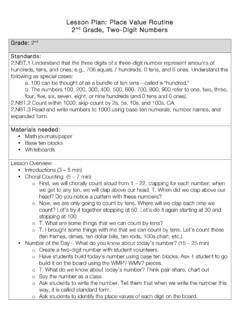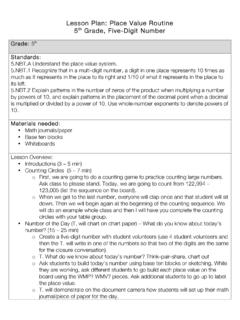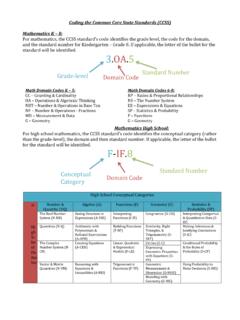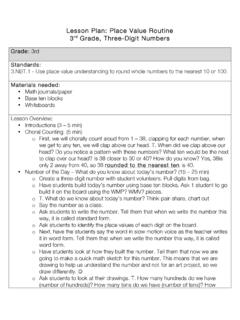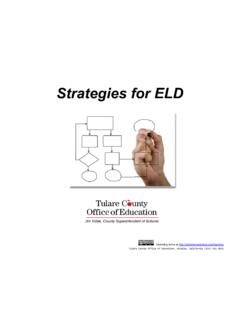Transcription of English Language Arts Bookmarks
1 English English Language arts Language arts Bookmarks Bookmarks Standards Reference to Support Standards Reference to Support Planning and Instruction Planning and Instruction 1st grade 1st grade 1st grade reading Standards for literature 1st grade reading Standards for literature 1. Anchor Standard Anchor Standard Read closely to determine what the text says explicitly and Read closely to determine what the text says explicitly and to make logical inferences from it; cite specific textual to make logical inferences from it; cite specific textual evidence when writing or speaking to support conclusions evidence when writing or speaking to support conclusions drawn from the text. drawn from the text. Ask and answer questions about key details in a text. Ask and answer questions about key details in a text.
2 Essential Skills and Concepts: Essential Skills and Concepts: q Ask questions about a text q Ask questions about a text q Answer questions about a text q Answer questions about a text q Give details q Give details q Read for details q Read for details Question Stems and Prompts: Question Stems and Prompts: Who was the story about? Who was the story about? What was the story about? What was the story about? What happened in the story? What happened in the story? What happened at the beginning, middle, and end of What happened at the beginning, middle, and end of the story? the story? Ask your partner to share a detail from the text. Ask your partner to share a detail from the text. Turn to your partner and ask a question about this Turn to your partner and ask a question about this book.
3 Book. Academic Vocabulary Spanish Cognates Academic Vocabulary Spanish Cognates details detalles details detalles questions preguntas questions preguntas ask ask answer answer text texto text texto information informaci n information informaci n answer answer 6th edition, 2/2019 6th edition, 2/2019. 1st grade reading Standards for literature 1st grade reading Standards for literature 2. Anchor Standard Anchor Standard Determine central ideas or themes of a text and analyze Determine central ideas or themes of a text and analyze their development; summarize the key supporting details their development; summarize the key supporting details and ideas. and ideas. Retell stories, including key details, and demonstrate Retell stories, including key details, and demonstrate understanding of their central message or lesson.
4 Understanding of their central message or lesson. Essential Skills and Concepts: Essential Skills and Concepts: q Understand key details q Understand key details q Understand sequential order q Understand sequential order q Identify and verbalize key details and main events q Identify and verbalize key details and main events within the story within the story q Retell the story in sequential order q Retell the story in sequential order q Identify and verbalize the problem or conflict in the q Identify and verbalize the problem or conflict in the story story q Identify and verbalize how the problem or conflict q Identify and verbalize how the problem or conflict was resolved within the story was resolved within the story Question Stems and Prompts: Question Stems and Prompts: Retell what happened in the story.
5 Retell what happened in the story. What is this story mainly about? What is this story mainly about? What is the central message in this story? What is the central message in this story? What problems did the characters have? What problems did the characters have? How did the characters solve their problem? How did the characters solve their problem? What lessons were learned in the story? What lessons were learned in the story? Academic Vocabulary Spanish Cognates Academic Vocabulary Spanish Cognates retell retell details detalles details detalles main event main event story story problem problema problem problema resolution/ending resoluci n resolution/ending resoluci n lesson or moral lesson or moral sequence secuencia sequence secuencia (Beginning, middle, end) (Beginning, middle, end).
6 Solve solve 6th edition, 2/2019 6th edition, 2/2019. 1st grade reading Standards for literature 1st grade reading Standards for literature 3. Anchor Standard Anchor Standard Analyze how and why individuals, events, and ideas Analyze how and why individuals, events, and ideas develop and interact over the course of a text. develop and interact over the course of a text. Describe characters, settings, and major events in a story, Describe characters, settings, and major events in a story, using key details. using key details. Essential Skills and Concepts: Essential Skills and Concepts: q Understand character q Understand character q Identify characters within the story q Identify characters within the story q Identify main character of the story q Identify main character of the story q Identify the minor character of the story q Identify the minor character of the story q Identify and verbalize major story events, citing key q Identify and verbalize major story events, citing key details details q Identify key events and details of story in sequential q Identify key events and details of story in sequential order (problem-resolution) order (problem-resolution).
7 Q Understand the lesson or moral of a story q Understand the lesson or moral of a story Question Stems and Prompts: Question Stems and Prompts: Who are the characters in the story? Who are the characters in the story? Describe the characters in the story? Describe the characters in the story? Who is the main character in the story? Describe Who is the main character in the story? Describe him/her. him/her. Describe the setting of the story. Describe the setting of the story. What is the problem or plot in the story? What is the problem or plot in the story? How do the characters in the story solve their How do the characters in the story solve their problem? problem? What happens at the beginning, middle, and end of What happens at the beginning, middle, and end of the story?
8 The story? Use details from the text to describe what Use details from the text to describe what happened. happened. Academic Vocabulary Spanish Cognates Academic Vocabulary Spanish Cognates describe describe characters characters setting setting plot plot events eventos events eventos sequence secuencia sequence secuencia problem problema problem problema resolution resoluci n resolution resoluci n lesson or moral lecci n o moraleja lesson or moral lecci n o moraleja 6th edition, 2/2019 6th edition, 2/2019. 1st grade reading Standards for literature 1st grade reading Standards for literature 4. Anchor Standard Anchor Standard Interpret words and phrases as they are used in a text, Interpret words and phrases as they are used in a text, including determining technical, connotative, and figurative including determining technical, connotative, and figurative meanings, and analyze how specific word choices shape meanings, and analyze how specific word choices shape meaning or tone.
9 Meaning or tone. Identify words and phrases in stories or poems that suggest Identify words and phrases in stories or poems that suggest feelings or appeal to the senses. (See grade 1 Language feelings or appeal to the senses. (See grade 1 Language standards 4-6 for additional expectations.) CA standards 4-6 for additional expectations.) CA. Essential Skills and Concepts: Essential Skills and Concepts: q Understand the differences between, words, phrases q Understand the differences between, words, phrases and sentences and sentences q Identify words, phrases and sentences q Identify words, phrases and sentences q Ask and answer questions about story details q Ask and answer questions about story details q Understand that words are clues to what characters q Understand that words are clues to what characters are thinking are thinking q Identify words that indicate use of the 5 senses q Identify words that indicate use of the 5 senses.
10 See, hear, smell, touch, taste see, hear, smell, touch, taste q Identify words that communicate feelings .happy, q Identify words that communicate feelings .happy, sad, angry, worry, fear sad, angry, worry, fear Question Stems and Prompts: Question Stems and Prompts: How does this story or poem make you feel when How does this story or poem make you feel when you read it? you read it? Does the character use his/her five senses in this Does the character use his/her five senses in this story? story? How do we know the character feels happy, sad, or How do we know the character feels happy, sad, or angry? angry? Identify what the character hears, sees, Identify what the character hears, sees, . What words in the story tell us what the setting What words in the story tell us what the setting looks like?
